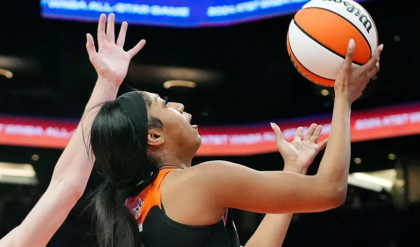In a watershed moment for women’s basketball, Caitlin Clark’s standout performance during the WNBA All-Star Game propelled viewership to unprecedented heights, drawing 3.44 million viewers and eclipsing all previous records.
Clark’s electrifying presence not only captivated fans but also ignited a compelling narrative surrounding her omission from Team USA—a storyline that intensified her rivalry with other top WNBA stars and significantly boosted interest in the event.
The game itself was a showcase of talent and intensity, with Clark’s on-court collaboration with Angel Reese underscoring their transition from rivals to teammates for the evening.
This dynamic duo’s synergy, along with stellar performances from legends like Lisa Leslie and Cheryl Swoopes, contributed to the game’s status as the most watched event in WNBA history. Airing on ABC during prime time strategically maximized exposure, reflecting the league’s strategic push to elevate women’s sports to broader audiences.

Beyond the immediate spectacle, the surge in viewership underscores a broader trend of growth within the WNBA.
The league’s average viewership per game has surpassed one million, signaling a burgeoning interest in women’s basketball nationwide. This momentum is further bolstered by a projected media rights deal valued at $2.2 billion, a monumental leap that underscores the league’s financial viability and potential for continued expansion.
However, amidst these triumphs, challenges persist. Debates over the league’s revenue valuation and player treatment remain contentious, with figures like Cheryl Miller advocating for a reevaluation that reflects the true market potential of women’s sports.
Maintaining robust fan engagement is paramount, as fluctuations in viewer interest could impact future revenue streams and the overall health of the league.

Commissioner Kathy Engelbert’s strategic oversight and the league’s commitment to equitable treatment and visibility for its stars like Caitlin Clark will be pivotal in navigating these complexities. As the WNBA continues to evolve, its ability to harness these opportunities while addressing critical issues will determine its trajectory in the competitive landscape of professional sports.
In conclusion, Caitlin Clark’s stellar showing in the WNBA All-Star Game symbolizes more than just athletic prowess—it represents a turning point for women’s basketball, where talent, narrative, and strategic vision converge to propel the league to new heights of popularity and financial success.
News
I’M DONE WITH YOU! Harry Shocks With Rage As Meghan Pack All Her Bags And Leave Montecito At 7Am
Prince Harry and Meghan Markle’s recent argument in Montecito has ignited intense public and media scrutiny. Witnesses reported a heated exchange, with Meghan hastily packing her belongings and leaving at 2 a.m., while Harry was heard shouting, “I’m done with…
SHE ASKED ME TO DESTROY HER! Meg TERRIFIED As Anne Honours Queen Last WISH To Destroy Netflix Act
In her final days, Queen Elizabeth II made one last request of her only daughter, Princess Anne. The aging monarch was deeply concerned about the damage being done to the royal family’s reputation by Prince Harry and Meghan, the Duke…
THAT WASN’T ARCHIE! Arthur Edwards EXPOSES Meghan’s 4 Year Secret About Staged Photo Of Fake Archie
The Royal Baby Photo Call: A Storm of Controversy Brews The birth of Archie Mountbatten-Windsor, Prince Harry and Meghan Markle’s first child, was a momentous occasion, eagerly anticipated by the world. However, the public introduction of their newborn son at…
HOW DARE YOU! Kate REOPENS Meghan SLAPP!NG Case Of Princess Charlotte & Files LawSuit After CBS Talk
The simmering feud between the Sussexes and the Royal Family has erupted into a full-blown war, with the Palace launching a blistering counter-attack against Meghan Markle’s claims of being bullied. In a stunning reversal of the narrative, the Palace has…
TRAGIC EVENT! Meghan & Harry To SELL £11M Mansion As They Are Chased Out By Montecito Neighbors
The gates of the sprawling $11 million Montecito estate swung open as the black SUV sped out, leaving the luxurious property behind in a cloud of dust. Inside the vehicle, the driver’s knuckles were white as they gripped the steering…
Meghan Gets OFFENDED by Jane Pauley Questions about Her Kids On CBS Sunday Morning Interview.
Meghan Markle’s recent interview with Jane Pauley on CBS has reignited controversy, particularly due to her visibly uncomfortable reaction to questions about her children. This incident has sparked renewed debate about the legitimacy of her family, with speculation growing over…
End of content
No more pages to load











